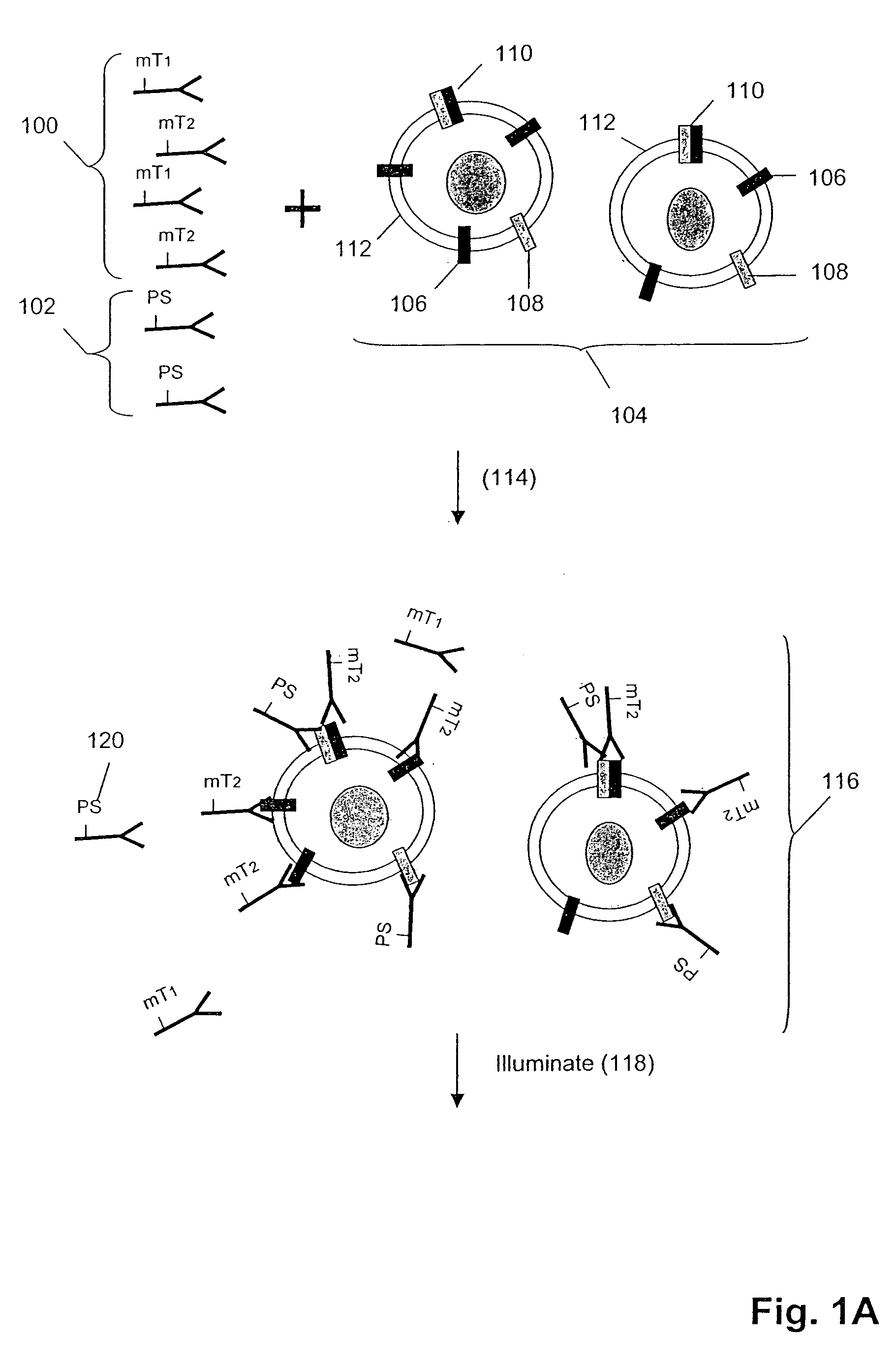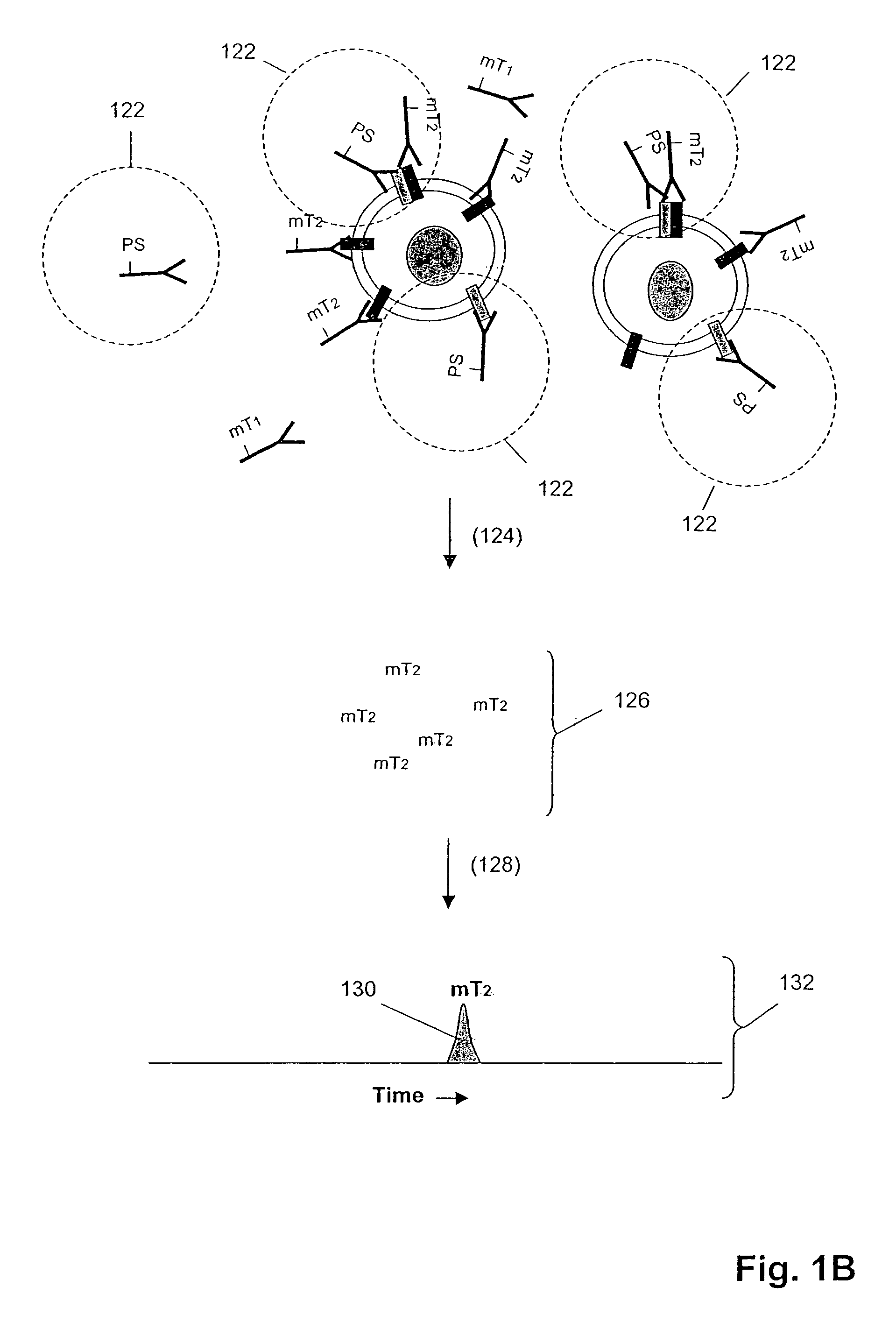Profiling frequencies of receptor heterodimers
a heterodimer and receptor technology, applied in the field of cell surface membrane receptors, can solve the problems of lack of flexibility, lack of convenient and sensitive techniques, and difficult application of techniques for measuring such interactions, so as to reduce background, facilitate multiplexing, and improve the effect of sensitivity
- Summary
- Abstract
- Description
- Claims
- Application Information
AI Technical Summary
Benefits of technology
Problems solved by technology
Method used
Image
Examples
example 1
Assay for Monitoring GABABR1 / GABABR2 Hetero-Oligomerization
[0213]The γ-aminobutyric acidB (GABA)B receptor, a G-protein coupled receptor (GPCR), mediates stimulation of high-affinity GTPase activity in brain membranes by GABA to regulate potassium and calcium channels. The active form of this receptor, localized to the cell surface, has been shown to be a hetero-oligomer comprising the two receptors GABABR1 and GABABR2, which are both class III GPCRs and share 35% sequence identity (Jones, et al., 1998, Kaupmann, et al., 1998, White, et al., 1998, Milligan, 2001).
[0214]GABAB receptor hetero-oligomerization can be monitored using the methods of the present invention: First, epitope-tagged GABABR1 and GABABR2 receptors are generated and transfected into HEK293T cells as described by White, et al. (1998).
[0215]Protocol for Transfection of HEK293T Cells with GABABR1 and GABABR2 Coding Sequence[0216]1. cDNA encoding a Myc epitope (used with monoclonal antibody 9E10) is fused in-frame to ...
example 2
Analysis of Cell Lysates for Her-2 Heterodimerization and Receptor Phosphorylation
[0226]In this example, Her1-Her2 and Her2-Her3 heterodimers and phosphorylation states are measured in cell lysates from several cell lines after treatment with various concentrations of epidermal growth factor (EGF) and heregulin (HRG). Measurements are made using three binding compounds and a cleaving probe as described below.
Sample Preparation:
[0227]1. Serum-starve breast cancer cell line culture overnight before use.[0228]2. Stimulate cell lines with EGF and / or HRG in culture media for 10 minutes at 37° C. Exemplary doses of EGF / HRG are 0, 0.032, 0.16, 0.8, 4, 20, 100 nM for all cell lines (e.g. MCF-7, T47D, SKBR-3) except BT20 for which the maximal dose is increased to 500 nM because saturation is not achieved with 100 nM EGF.[0229]3. Aspirate culture media, transfer onto ice, and add lysis buffer to lyse cells in situ.[0230]4. Scrape and transfer lysate to microfuge tube. Incubate on ice for 30 m...
example 3
Analysis of Tissue Lysates for Her2 Heterodimerization and Receptor Phosphorylation
[0256]In this example, Her1 -Her2 and Her2-Her3 heterodimers and phosphorylation states are measured in tissue lysates from human breast cancer specimens.
Sample Preparation:
[0257]1. Snap frozen tissues are mechanically disrupted at the frozen state by cutting.[0258]2. Transfer tissues to microfuge tube and add 3×tissue volumes of lysis buffer (from appendix I) followed by vortexing to disperse tissues in buffer.[0259]3. Incubate on ice for 30 min with intermittent vortexing to mix.[0260]4. Centrifuge at 14,000 rpm, 4° C., for 20 min.[0261]5. Collect supernatants as lysates and determine total protein concentration with BCA assay (Pierce) using a small aliquot.[0262]6. Aliquot the rest for storage at −80° C. until use.
Assay design:[0263]1. The total assay volume is 40 ul.[0264]2. The lysates are tested in serial titration series of 40, 20, 10, 5, 2.5, 1.25, 0.63, 0.31 ug total-equivalents and the volum...
PUM
| Property | Measurement | Unit |
|---|---|---|
| molecular weight | aaaaa | aaaaa |
| diameter | aaaaa | aaaaa |
| pressure | aaaaa | aaaaa |
Abstract
Description
Claims
Application Information
 Login to View More
Login to View More - R&D
- Intellectual Property
- Life Sciences
- Materials
- Tech Scout
- Unparalleled Data Quality
- Higher Quality Content
- 60% Fewer Hallucinations
Browse by: Latest US Patents, China's latest patents, Technical Efficacy Thesaurus, Application Domain, Technology Topic, Popular Technical Reports.
© 2025 PatSnap. All rights reserved.Legal|Privacy policy|Modern Slavery Act Transparency Statement|Sitemap|About US| Contact US: help@patsnap.com



